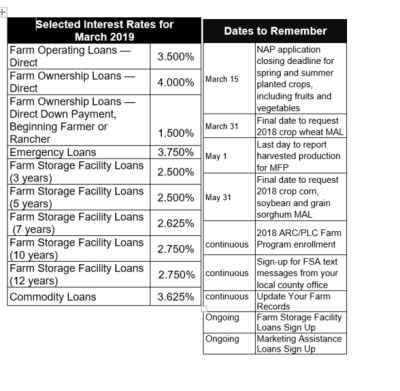|
 The FSA State Committee are responsible for the oversight of
farm programs and county committee operations, hearing appeals
from The FSA State Committee are responsible for the oversight of
farm programs and county committee operations, hearing appeals
from
the agriculture community, and helping to keep producers
informed about FSA programs.
Kirk Liefer and his wife Stephanie, along with their five
children live in Red Bud, IL. They are the owners of CH Farms,
LLC and farm with Kirk’s parents and two younger brothers and
their spouses. They raise corn, soybeans, wheat, and raise
soybeans for Pioneer Hi-Bred. Their family farm also has a
Pioneer Hi-Bred seed dealership. In 2018 they opened a brewery,
Lieferbrau, with Kirk's younger siblings and their spouses.
Welcome to FSA Kirk!
I would also like to remind producers of the May 1, 2019,
deadline to certify their production for MFP benefits.
-----
Beginning Farmer Loans
FSA assists beginning farmers to finance agricultural
enterprises. Under these designated farm loan programs, FSA can
provide financing to eligible applicants through either direct
or guaranteed loans. FSA defines a beginning farmer as a person
who:

Has operated a farm for not more than 10 years Will materially
and substantially participate in the operation of the farm
Agrees to participate in a loan assessment, borrower training
and financial management program sponsored by FSA
Does not own a farm in excess of 30 percent of the county’s
average size farm. Additional program information, loan
applications, and other materials are available at your local
USDA Service Center. You may also visit
www.fsa. usda.gov.
USDA Announces Streamlined Guaranteed Loans
and Additional Lender Category for Small-Scale Operators
Options Help More Beginning, Small and Urban
Producers Gain Access to Credit
The U.S. Department of Agriculture (USDA) announced the
availability of a streamlined version of USDA guaranteed loans,
which are tailored for smaller scale farms and urban producers.
The program, called EZ Guarantee Loans, uses a simplified
application process to help beginning, small, underserved and
family farmers and ranchers apply for loans of up to $100,000
from USDA-approved lenders to purchase farmland or finance
agricultural operations.
A new category of lenders will join traditional lenders, such as
banks and credit unions, in offering USDA EZ Guarantee Loans.
Microlenders, which include Community Development Financial
Institutions and Rural Rehabilitation Corporations, will be able
to offer their customers up to $50,000 of EZ Guaranteed Loans,
helping to reach urban areas and underserved producers. Banks,
credit unions and other traditional USDA-approved lenders, can
offer customers up to $100,000 to help with agricultural
operation costs.
EZ Guarantee Loans offer low interest rates and terms up to
seven years for financing operating expenses and 40 years for
financing the purchase of farm real estate. USDA-approved
lenders can issue these loans with the Farm Service Agency (FSA)
guaranteeing the loan up to 95 percent.
More information about the available types of FSA farm loans can
be found at
www.fsa.usda.gov/farmloans or by contacting your local
FSA office.
-----
Emergency Disaster Declarations and
Designations
Farmers and ranchers know all too well that natural disasters
can be a common, and likely a costly, variable to their
operation. The Farm Service Agency (FSA) has emergency
assistance programs to provide assistance when disasters strike,
and for some of those programs, a disaster designation may be
the eligibility trigger. When natural disaster occurs, there is
a process for requesting a USDA Secretarial disaster designation
for a county. Agricultural producers can play a vital role in
this process.
If you have experienced a production loss as a result of a
natural disaster, you may submit a request to your local FSA
county office for your county to be evaluated for a Secretarial
disaster designation. Once a request is received, the county
office will collect disaster data and create a Loss Assessment
Report. The County Emergency Board will review the Loss
Assessment Report and determine if a recommendation will be sent
forward.

-----
USDA Secretarial Disaster Designation
The designation process can be initiated by individual farmers,
local government officials, State governors, State agriculture
commissions, tribal councils or the FSA State Executive Director
This designation is triggered by a 30-percent or greater
production loss to at least one crop because of a natural
disaster, or at least 1 producer who sustained individual losses
because of a natural disaster and is unable to obtain commercial
financing to cover those losses
In 2012, USDA developed a fast-track process for disaster
declarations for severe drought. This provides for a nearly
automatic designation when, during the growing season, any
portion of a county meets the D2 (Severe Drought) drought
intensity value for eight consecutive weeks or a higher drought
intensity value for any length of time as reported by the U.S.
Drought Monitor -
http://drought monitor.unl.edu FSA administers four
types of disaster designations. All four types of designations
immediately trigger the availability of low-interest Emergency
loans to eligible producers in all primary and contiguous
counties.
FSA borrowers in these counties who are unable to make their
scheduled payments on any debt may be authorized to have certain
set asides. Additional disaster assistance requiring a
designation may also be provided by new programs in the future.
For more information on FSA disaster programs and disaster
designations, visit
www.fsa.usda. gov/disaster
-----
Farm Storage Facility Loans
FSA’s Farm Storage Facility Loan (FSFL) program
provides low-interest financing to producers to build or upgrade
storage facilities and to purchase portable (new or used)
structures, equipment and storage and handling trucks.
The low-interest funds can be used to build or upgrade permanent
facilities to store commodities. Eligible commodities include
corn, grain sorghum, rice, soybeans, oats, peanuts, wheat,
barley, minor oilseeds harvested as whole grain, pulse crops
(lentils, chickpeas and dry peas), hay, honey, renewable
biomass, fruits, nuts and vegetables for cold storage
facilities, floriculture, hops, maple sap, rye, milk, cheese,
butter, yogurt, meat and poultry (unprocessed), eggs, and
aquaculture (excluding systems that maintain live animals
through uptake and discharge of water). Qualified facilities
include grain bins, hay barns and cold storage facilities for
eligible commodities.
Loans up to $100,000 can be secured by a promissory
note/security agreement. Loans exceeding $100,000 require
additional security.
Producers do not need to demonstrate the lack of commercial
credit availability to apply. The loans are designed to assist a
diverse range of farming operations, including small and
mid-sized businesses, new farmers, operations supplying local
food and farmers markets, non-traditional farm products, and
underserved producers.
[to top of second column] |

To learn more about the FSA Farm Storage Facility
Loan, visit
www.fsa.usda. gov/pricesupport or contact your local FSA
county office. To find your local FSA county office, visit
http://offices. usda.gov.
-----
Marketing Assistance Available for 2018 Crops
The 2014 Farm Bill authorized 2014-2018 crop year Marketing
Assistance Loans (MALs) and Loan Deficiency Payments (LDPs).
MAL’s provide financing and marketing assistance for 2018 crop
wheat, feed grains, soybeans and other oilseeds, pulse crops,
wool and honey. MAL’s provide producers interim financing after
harvest to help them meet cash flow needs without having to sell
their commodities when market prices are typically at
harvest-time lows.
A producer who is eligible to obtain an MAL, but agrees to forgo
the loan, may obtain an LDP if such a payment is available.
To be eligible for an MAL or an LDP, producers must have a
beneficial interest in the commodity, in addition to other
requirements. A producer retains beneficial interest when
control of and title to the commodity is maintained. For an LDP,
the producer must retain beneficial interest in the commodity
from the time of planting through the date the producer filed
Form CCC-633EZ (page 1) in the FSA County Office. For more
information, producers should contact their local FSA county
office or view the LDP Fact Sheet.
-----
Unauthorized Disposition of Grain
If loan grain has been disposed of through feeding, selling or
any other form of disposal without prior written authorization
from the county office staff, it is considered unauthorized
disposition. The financial penalties for unauthorized
dispositions are severe and a producer’s name will be placed on
a loan violation list for a two-year period. Always call before
you haul any grain under loan.
-----
Reporting Solar Panels Constructed on Cropland
Producers who have solar panels constructed on their farms
should notify the local Farm Service Agency office. Any area
that is no longer considered suitable as cropland (producing
annual or perennial crops) should be designated in FSA’s records
and aerial photography maps. When base acres on a farm are
converted to a non-agricultural commercial or industrial use,
the total base acres on the farm must be reduced accordingly.
Non-cropland areas used for solar panels might impact payments
calculated using base acres, such as Agriculture Risk Coverage
(ARC) and Price Loss Coverage (PLC) and Conservation Reserve
Program (CRP) annual rental payments.

-----
Reporting Wind Turbines Constructed on
Cropland
Producers who have wind turbines constructed on their farms
should notify the local Farm Service Agency office. Any area
that is no longer considered suitable as cropland (producing
annual or perennial crops) should be designated in FSA’s records
and aerial photography maps. When base acres on a farm are
converted to a non-agricultural commercial or industrial use,
the total base acres on the farm must be reduced accordingly.
Non-cropland areas used for wind turbines might impact payments
calculated using base acres, such as Agriculture Risk Coverage
(ARC) and Price Loss Coverage (PLC) and Conservation Reserve
Program (CRP) annual rental payments.
-----
Farm Reconstitutions
When changes in farm ownership or operation take
place, a farm reconstitution is necessary. The reconstitution —
or recon — is the process of combining or dividing farms or
tracts of land based on the farming operation.
To be effective for the current Fiscal Year (FY), farm
combinations and farm divisions must be requested by August 1 of
the FY for farms subject to the Agriculture Risk Coverage (ARC)
and Price Loss Coverage (PLC) program. A reconstitution is
considered to be requested when all:
of the required signatures are on FSA-155
other applicable documentation, such as proof of ownership, is
submitted.
Total Conservation Reserve Program (CRP) and non-ARC/PLC farms
may be reconstituted at any time.
The following are the different methods used when doing a farm
recon:
Estate Method — the division of bases, allotments and
quotas for a parent farm among heirs in settling an estate;
Designation of Landowner Method — may be used when (1)
part of a farm is sold or ownership is transferred; (2) an
entire farm is sold to two or more persons; (3) farm ownership
is transferred to two or more persons; (4) part of a tract is
sold or ownership is transferred; (5) a tract is sold to two or
more persons; or (6) tract ownership is transferred to two or
more persons. In order to use this method the land sold must
have been owned for at least three years, or a waiver granted,
and the buyer and seller must sign a Memorandum of
Understanding;
DCP Cropland Method — the division of bases in the same
proportion that the DCP cropland for each resulting tract
relates to the DCP cropland on the parent tract;

Default Method — the division of bases for a parent farm
with each tract maintaining the bases attributed to the tract
level when the reconstitution is initiated in the system.
-----

Illinois Farm Service Agency
3500 Wabash Ave.
Springfield, IL 62711
Phone: 217-241-6600 ext. 2
Fax: 855-800-1760
www.fsa.usda.gov/il
State Executive Director:
William J. Graff
State Committee:
James Reed-Chairperson
Melanie DeSutter-Member
Kirk Liefer-Member
George Obernagel III-Member
Troy Uphoff-Member
Administrative Officer:
Dan Puccetti
Division Chiefs:
John Gehrke
Randy Tillman
To find contact information for your local office go to
www.fsa.usda.gov/il
USDA is an equal opportunity provider, employer and lender. To file
a complaint of discrimination, write: USDA, Office of the Assistant
Secretary for Civil Rights, Office of Adjudication, 1400
Independence Ave., SW, Washington, DC 20250-9410 or call (866)
632-9992 (Toll-free Customer Service), (800) 877-8339 (Local or
Federal relay), (866) 377-8642 (Relay voice users). |